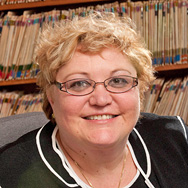Julie Ann Barna, D.M.D., Lewisburg, PA
How has your PBRN experience benefitted you professionally?
There really is no other way to say it. Joining a PBRN is the best thing that I’ve done for my practice, my patients, and actually myself since graduating from dental school.
Why’s that?
I think it’s a matter of professional outlook. After practicing for 32 years, you start to worry about slowing down or even burning out. I had pushed myself to read journals, attend continuing education seminars, and join a study club. But all of the extra effort only went so far. Something was still missing. Joining the PBRN filled the void. Instead of reading about the future of dentistry, I was a part of doing the research and building that future. I’ve met colleagues through the PBRN network who have been some of the best and brightest, and they’ve given me ideas and helped to re-energize me in my practice. The PBRN is really the best cure for any kind of burn out or lethargy in private practice. I’ve just had nothing but positive experiences.
You’ve been a PBRN member for three years. How many studies have you participated in?
I’ve participated in five studies. For three of them, I’ve contributed quite a lot of time and enrolled many patients. One study evaluated the success of root canals three to five years post surgery. Another looked at the effect and degree of analgesics in different dental procedures. Then, the randomized controlled study involved gingival sensitivity. The office computer randomized whether the patient would get toothpaste, a sealant, or a filling. For that study, I provided 40 patients.
What did you learn from participating in the gingival sensitivity study?
Well, it gave me a broader base from which to evaluate these patients over time. I can now personalize my consultation with my patients based on the PBRN experience. I can tell them about the trends that I saw in my 40 study participants. I can tell them what was the most or least successful within certain parameters. I also know what was effective in my hands. Certainly that’s what all patients look for. What works best in your practice. Bottom line, I’ve learned a lot about scientific studies, and I believe this is the way that you’re going to see lifelong learning in our profession in the years ahead.
Julie Ann Barna, D.M.D.
Lewisburg, PA
July 2018

